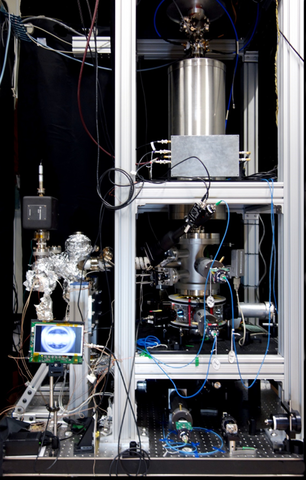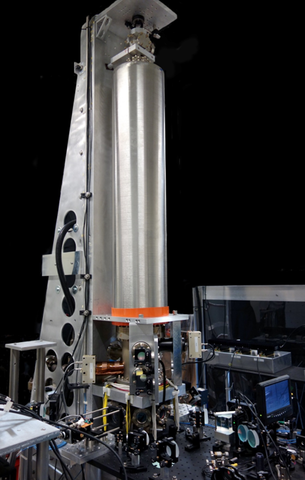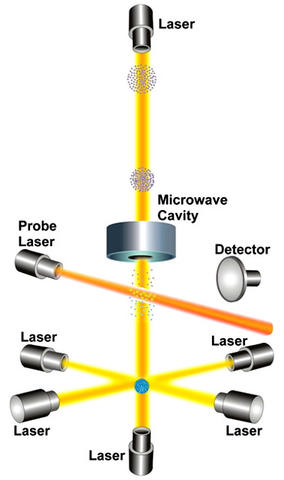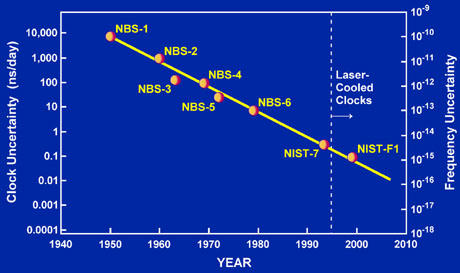NIST’s Cesium Fountain Atomic Clocks

NIST-F3
Primary Frequency Standards for the United States
The nation's primary frequency standard is a cesium fountain atomic clock developed at the NIST laboratories in Boulder, Colorado. A primary frequency standard contributes to the calibration of the official international time scale Coordinated Universal Time (UTC), and to its local realization UTC(NIST) which is synthesized and distributed from the NIST laboratories in Boulder.
For many years, the primary frequency standard was a Cesium fountain known as NIST-F1 which operated from 2000 to 2015. A cryogenic Cesium fountain known as NIST-F2 was also developed during this time. The NIST fountain group currently operates two Cesium fountains known as NIST-F3 and NIST-F4.

NIST-F4 is a primary frequency standard that is currently under evaluation. This fountain is an upgrade of the NIST-F1 apparatus. Once the evaluation is completed, NIST-F4 will contribute to UTC and calibrate the absolute frequency of next-generation optical atomic clocks. It is expected to reach an accuracy approaching the 10-16 level in fractional frequency.
NIST-F3 is a cesium fountain frequency reference. Unlike the other NIST fountains, NIST-F3 is not intended to realize the definition of the second of the International System of Units (SI) with state-of-the-art accuracy. Instead, NIST-F3 is intended to be a stable system that operates with high up-time. It will provide a stable frequency reference that can be used in the NIST time scale and assist with the evaluation of NIST’s primary and secondary frequency standards.
Initial evaluations of NIST-F3’s frequency offset and stability were completed recently. The frequency offset of NIST-F3 has been characterized to within a few parts in 10-15 in fractional frequency units. In the first measurement campaign, NIST-F3’s frequency offset exhibited drift below 10-17/day over five months. This long-term stability is about a factor of 100 better than can be achieved with a hydrogen maser, and it illustrates the advantages of a cold-atom frequency reference. Work is ongoing to evaluate the stability of the apparatus and to characterize the residual frequency biases in NIST-F3.
The links to previous Cs fountains can be found in NIST-F1 and NIST-F2.
Technical Description
NIST-F3 and NIST-F4 are referred to as fountain clocks because they use a fountain-like movement of atoms to calibrate the offset of a microwave frequency from the unperturbed cesium clock transition frequency used to define the SI second.. First, a gas of cesium atoms is introduced into the clock's vacuum chamber. Six infrared laser beams then are directed at right angles to each other at the center of the chamber. The lasers slow down the atoms, and a cold cloud of cesium atoms forms in the intersection of the six laser beams. The residual motion of the atoms forming the cloud corresponds to temperatures near absolute zero.
After the cooling process, the two vertical lasers are used to gently toss the cloud upward (the "fountain" action), and then all the lasers are turned off. The controlled cloud velocity is just enough to send the cloud about a meter high through a microwave-filled cavity. Under the influence of gravity, the cloud in a free fall passes the microwave cavity a second time.
The round trip up and down through the microwave cavity lasts for about half a second. During the passage through the microwave cavity, the atoms could change from one to the other of their two internal clock states because of the interaction with the microwave signal. When the atoms exit the microwave cavity, they cross consecutively two horizontal laser beams, each addressing one of the two clock states the atoms find themselves in. Light from each of these laser beams is absorbed by the atoms, and as they emit light back (a process known as fluorescence), the photons, or the tiny packets of light that they emit, are measured by a detector.

This process is repeated many times while the microwave signal in the cavity is tuned to different frequencies. Eventually, a microwave frequency is found that alters the clock states of most of the cesium atoms and maximizes their fluorescence. This frequency is the natural resonance frequency of the cesium atom (9,192,631,770 Hz), or the frequency used to define the SI second.
The combination of laser cooling and the fountain design allows the atomic fountain clock to observe cesium atoms for longer periods compared to traditional atomic beam clocks, and thus achieve its unprecedented accuracy. Traditional cesium clocks measure room-temperature atoms moving at several hundred meters per second. Since the atoms are moving so fast, the observation time is limited to a few milliseconds. The fountain clock uses a different approach. Laser cooling drops the temperature of the atoms to a few millionths of a degree above absolute zero, and reduces their thermal velocity to a few centimeters per second. The laser cooled atoms are launched vertically and pass twice through a microwave cavity, once on the way up and once on the way down. The result is an observation time of about one second, which is limited only by the force of gravity pulling the atoms to the ground. As you might guess, the longer observation times make it easier to tune the microwave frequency.
The resonance frequency of the hyperfine splitting in cesium has defined the second since 1967. The history of the uncertainty in the measurement of this frequency at NIST is illustrated in the figure below:

Since the first evaluation of NIST-F1 summarized in the figure, cesium fountain clocks have improved by another order of magnitude and the definition of the second can now be realized with an uncertainty approaching 1×10-16 at metrological institutes around the world. This exquisite accuracy is possible because of the long interrogation times and detailed control of the atomic motion that is enabled by laser cooling. The next generation of atomic frequency reference utilize laser cooling and ultra-stable lasers to measure frequencies with a fractional uncertainty approaching 1×10-18 !
Publications
"Design and manufacture of a new microwave cavity assembly for use in cesium fountains at NIST“, G. Hoth, V. Gerginov, and K. Gibble, submitted to Proc. 2023 Joint Mtg. IEEE Intl. Freq. Cont. Symp. and EFTF Conf.
"NIST-F3, a cesium fountain frequency reference“, G. Hoth, A. Radnaev, P. Mitchell, J. Sherman, V. Gerginov, Proceedings of the 54th Annual Precise Time and Time Interval Systems and Applications (PTTI) Meeting, pp. 183-188, 2023
“Initial Study of the Distributed Cavity Phase Shift for the New Microwave Cavities of Cs Fountains at NIST”, G. Hoth, B. Patla, N. Ashby, V. Gerginov, Proc. Joint Mtg. IEEE Intl. Freq. Cont. Symp. and EFTF Conf., 2022
“First accuracy evaluation of NIST-F2”, T. Heavner, E. Donley, F. Levi, G. Costanzo, T. Parker, J. Shirley, N. Ashby, S. Barlow, S. Jefferts, Metrologia 51, 174–182. 2014
“NIST-F1: recent improvements and accuracy evaluations”, T. Heavner, S. Jefferts, E. Donley, J. Shirley, T. Parker, Metrologia 42, 411–422, 2005
“The accuracy evaluation of NIST-F1”, S. Jefferts, D. Meekhof, J. Shirley, T. Parker, Metrologia 39, 321-336, 2002
Contacts
-
(303) 497-7366
-
(303) 497-4414

